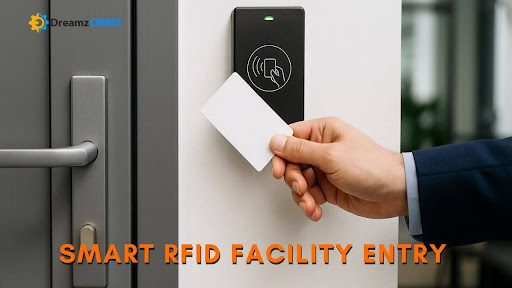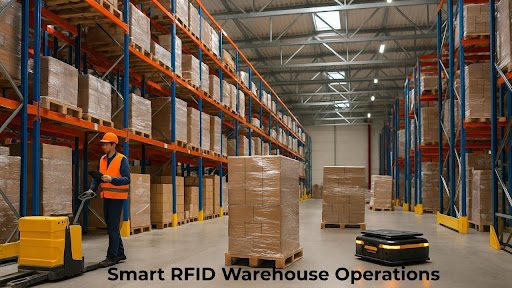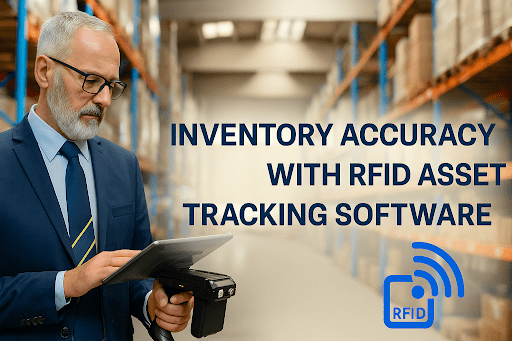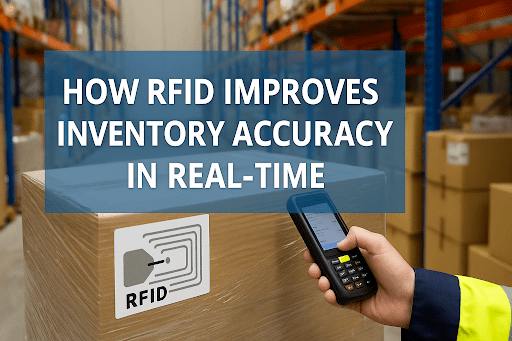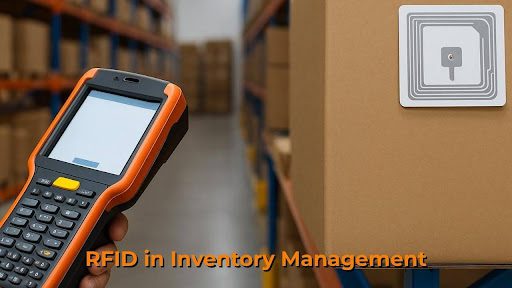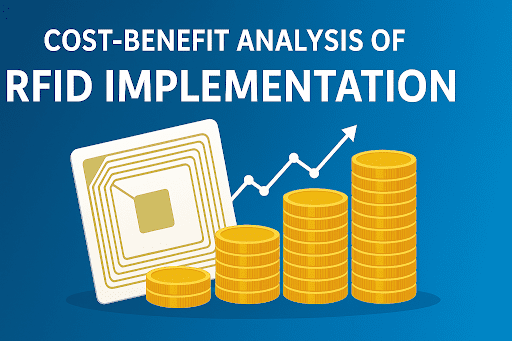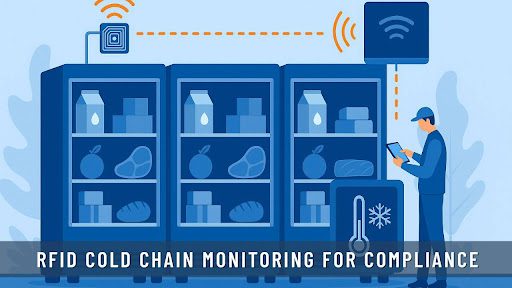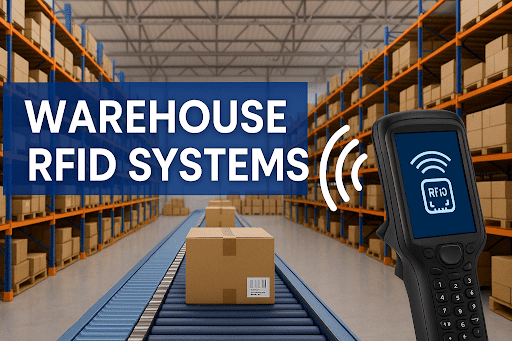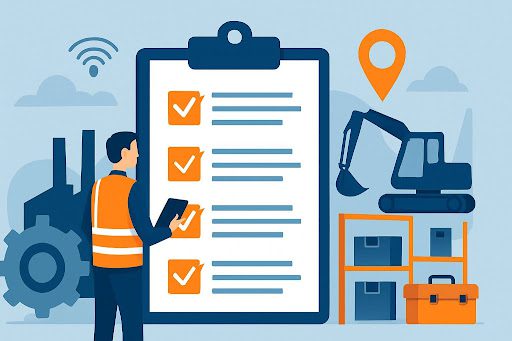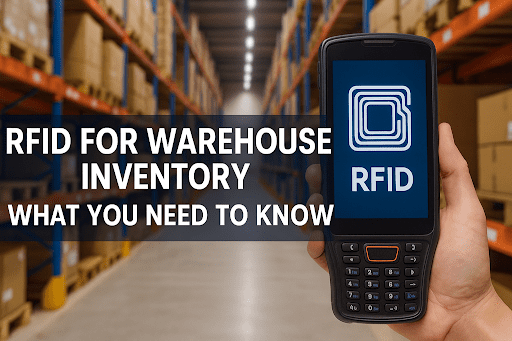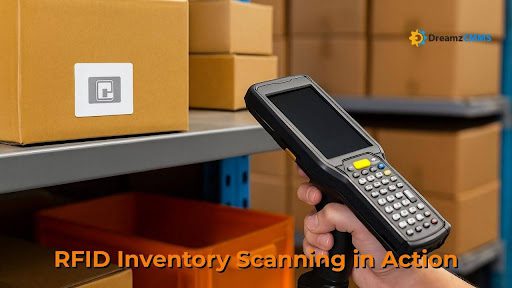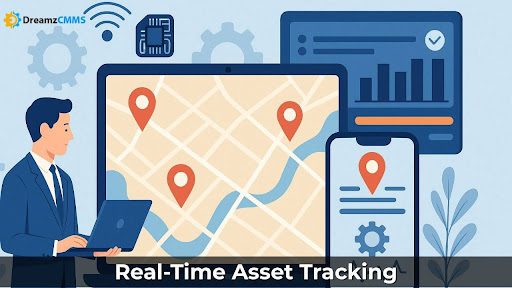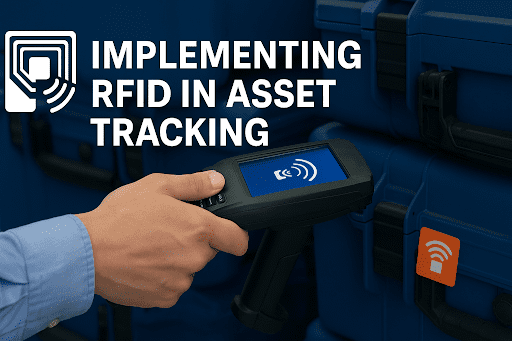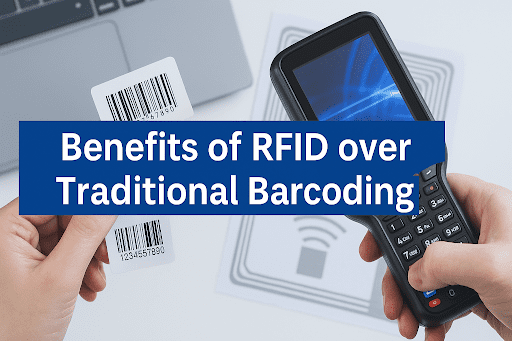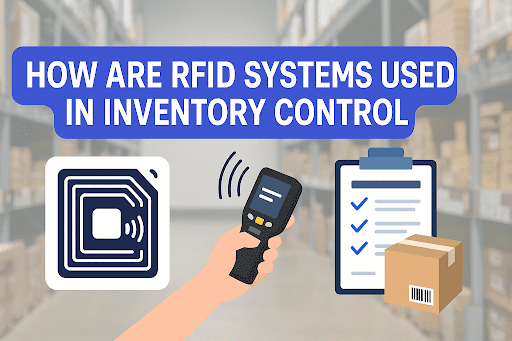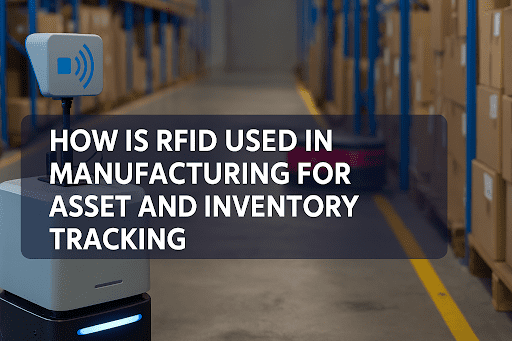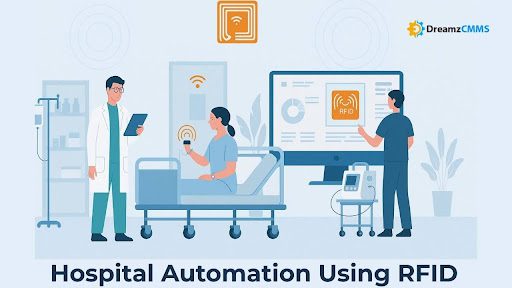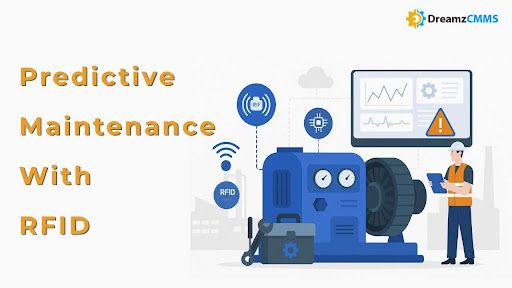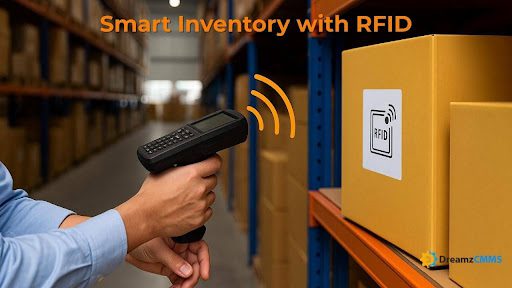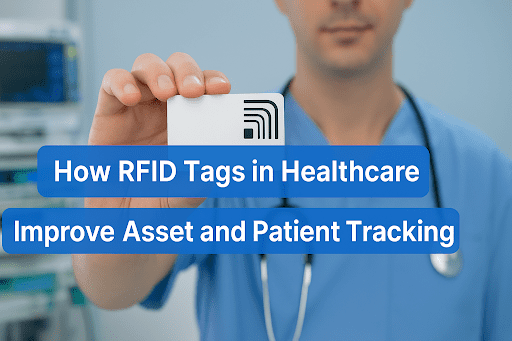 BACK TO Blog
BACK TO Blog
Asset Rental Management
RFID Asset Tracking
The current business environment demands efficient inventory management to achieve operational success. Radio Frequency Identification (RFID) stands as one of the most transformative business technologies which revolutionizes inventory management. Organizations with complex inventory systems use RFID to achieve real-time asset tracking which enables them to boost accuracy while maximizing stock
- August 12, 2025
- DreamzCMMS Team
- 9 minutes read
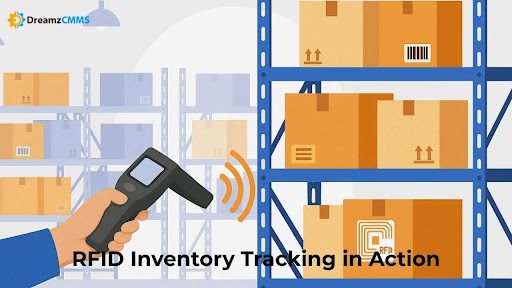
- August 12, 2025
- DreamzCMMS Team
- 9 minutes read
The current business environment demands efficient inventory management to achieve operational success. Radio Frequency Identification (RFID) stands as one of the most transformative business technologies which revolutionizes inventory management. Organizations with complex inventory systems use RFID to achieve real-time asset tracking which enables them to boost accuracy while maximizing stock levels. This guide provides step-by-step instructions for inventory tracking using RFID technology alongside explanations about its implementation process and optimal usage practices.
Optimize Your Asset Management Today!The Asset Maintenance Management Software provides complete control over your assets. The system enhances asset lifespan together with decreased downtime which results in better operational efficiency. Your assets will become more efficient with DreamzCMMS which operates as a smarter asset management platform today. |
What is RFID and How Does it Work?
An RFID tag maintains electronically stored data which RFID readers can detect. The fundamental elements of an RFID system consist of:
- RFID Tags: RFID Tags represent small devices used for item attachment which contain product ID and description and location information. There are two main types:
- Passive Tags: Passive Tags operate without batteries until an RFID reader activates them through contact.
- Active Tags: These have their own power source and can transmit data over longer distances.
- RFID Readers: Active Tags maintain their own power source to allow them to send data over extended distances. RFID Readers operate as devices that activate RFID tags while extracting transmitted data from them.
- Antennas: The antennas function as connectors which enable reader-tag signal exchange.
- RFID Software:RFID Software operates as the system which processes reader-collected data for inventory tracking and management.
Why Choose RFID for Inventory Tracking?
The analysis of RFID technology for inventory management begins by understanding its growing acceptance across warehouse and retail and logistics industries.
Key Benefits of RFID Inventory Tracking
- Time Savings: RFID systems allow automatic scanning of numerous items simultaneously which eliminates the requirement for manual scanning. The automated inventory processes including stocktaking and replenishment become faster because of RFID technology. The RFID system enables automatic inventory tracking which produces instantaneous data updates.
- Real-Time Inventory Visibility: RFID provides businesses with real-time visibility into asset status and their exact locations. Businesses that maintain extensive inventories together with multiple facilities find RFID systems particularly helpful. The instant supply chain data obtained from RFID systems helps managers optimize storage capacity while preventing stock-related deficits and excesses.
- Reduced Losses and Theft: The implementation of RFID technology allows businesses to monitor inventory movement in real time thus lowering the probability of stock losses and thefts. The exact product and asset tracking capability makes it more difficult for items to go missing or get stolen.
- Better Decision-Making: The real-time data from RFID systems helps businesses create better inventory decisions that result in correct stock availability at the appropriate time. Organizations can perform trend analysis of product movements to predict market needs and modify their purchasing approach.
- Cost Savings: The high initial setup cost of RFID systems leads to decreased labor expenses along with reduced stockouts and improved operational efficiency which generate long-term financial benefits. The implementation of RFID technology eliminates human labor requirements which leads to lower operational costs combined with better accuracy and fewer errors throughout time.
How to Use RFID to Track Inventory: Step-by-Step Setup
1. Select the Correct RFID Inventory Tracking System
The first necessary step for implementing RFID inventory tracking involves selecting the appropriate system that matches business requirements. You need to evaluate three factors for your inventory management needs:
- Your inventory size determines whether you need basic or advanced RFID systems with their respective capabilities and additional equipment specifications.
- The RFID system needs to support diverse product types including perishable goods and high-value assets through flexible operation.
The RFID system needs to operate with your current Warehouse Management Systems (WMS) and Enterprise Resource Planning (ERP) software through integrated capabilities. System integration enables perfect data transfer and accurate tracking between different systems.
2. RFID Tags and Inventory Management
After selecting an RFID system you must begin the process of tagging your inventory. The tags function as storage units that contain vital information which includes product ID and SKU along with other important details. You need to decide between Passive RFID tags (for small affordable products) and Active RFID tags (for valuable assets with extended tracking requirements).
Labeling involves placing RFID tags on your products or pallets or shelves. The tags need to display clearly while being attached to items in a way that enables proper system functionality. The correct placement of RFID tags directly affects the overall tracking precision of the system.
Custom RFID tags serve specific inventory requirements by incorporating temperature monitoring and weight tracking and product condition assessment capabilities. Organizations storing perishable goods and sensitive equipment must use RFID tags which withstand extreme temperatures to maintain reliable operations.
3. Install RFID Readers and Antennas
RFID tags need RFID readers strategically positioned across the warehouse and facility to operate effectively. Common locations include:
- Dock doors: To track incoming and outgoing shipments.
- Shelving units: For real-time inventory visibility.
- Workstations: For quick inventory checks during operations.
The placement of antennas adjacent to RFID readers enables efficient data exchange between tags and readers. Your facility size determines the need for several antennas to track multiple zones or extensive areas.
4. Integrate RFID Inventory Software
Software integration stands essential for managing and analyzing data which comes from RFID inventory monitoring setup. The RFID system records information about the movement along with location data and status information for every item. The following inventory tracking software features should be essential for any organization:
- Real-time updates: To ensure that the inventory data is always accurate. Real-time inventory visibility provides managers with immediate responses to both demand and supply changes in the market.
- Reporting tools: For generating reports on inventory levels, stock movement, and more. Through reports businesses can identify patterns to support data-based decisions about purchases and stock management as well as sales activities.
5. Test the System
The RFID inventory tracking system requires complete testing to verify that all components function correctly. Perform a full stock count using RFID and compare it against your manual records. The system testing process will reveal all issues that need correction before the complete implementation.
Organizations can refine their reader and antenna positions during system testing and adjust software configurations to maintain supply chain data consistency.
6. Train Staff on RFID Inventory Tracking
The implementation of RFID depends heavily on the training that staff members receive. Employees require training to use RFID readers properly and understand software data interpretation as well as identify and solve system problems. Staff members need to learn RFID inventory tracking best practices as part of their training to achieve smooth operations.A business can enhance system adoption rates and minimize disruptions stemming from incorrect usage and poor system integration by training employees about system operation and challenge resolution.
RFID Inventory Tracking Best Practices
Businesses can reach the best possible outcomes from RFID inventory tracking by following these established guidelines:
- Track Movement in Real-Time: Businesses should check inventory levels and movements in real time to maintain full tracking of their inventory. Fast-moving environments need real-time tracking because their inventory turnover rates remain high.
- Conduct Regular Audits: Use RFID technology to conduct regular inventory audits while comparing results with physical counts. The system verification process and early detection of discrepancies happen through these audits.
RFID vs Barcode Inventory Tracking: Key Differences
When deciding between RFID vs barcode inventory tracking, consider the following:
| Feature | RFID | Barcode |
| Read Range | Long-range (up to 100 meters) | Short-range (line of sight required) |
| Scan Speed | Multiple items at once | One item at a time |
| Durability | More durable (can withstand harsh conditions) | Less durable (prone to wear and tear) |
| Cost | Higher initial setup costs | Lower upfront costs |
| Data Storage | Can store more data (e.g., serial numbers, location) | Limited data storage |
The tracking needs of large-scale real-time operations with high speeds are best met by RFID technology although barcodes provide an effective and economical solution for managing small inventory amounts.
Multi-location RFID Inventory Tracking
Businesses operating in different locations require multi-location RFID inventory tracking as a fundamental practice. RFID systems maintain real-time inventory data synchronization between facilities. The integrated system provides simultaneous updates for all locations which helps organizations make better decisions while improving their stock management operations.
Benefits of Multi-location RFID Tracking:
- Centralized Control: The centralization of inventory data enables better product tracking across locations because it simplifies data management. The centralized system provides businesses with continuous visibility into inventory levels throughout all locations.
- Improved Accuracy: The system eliminates location-based discrepancies which helps maintain accurate stock levels throughout all locations. The synchronized data system enables companies to prevent discrepancies when they transfer items from one facility to another.
- Optimized Stock Transfer: The system enables faster and more data-driven stock transfers between locations by using current inventory information. The tracking capabilities of RFID enable companies to verify that their stock exists at required locations thus improving operational efficiency.
Automated Inventory Tracking with RFID
A suitable RFID system enables you to automate important inventory functions including:
- Replenishment: The system automatically triggers reorders when stock quantities reach a predefined minimum threshold. RFID technology enables businesses to perform automated reordering without needing manual tracking systems.
- Work Order Creation: Work Order Creation uses automation to produce work orders when items need maintenance or restocking. RFID enables automated work order generation through inventory movement or status changes.
- Shelf Restocking: The system will notify warehouse personnel through automatic alerts when warehouse products approach their minimum thresholds. This system operates automatically to maintain product availability at all times without human involvement.
RFID Inventory Tracking Solutions: The Future of Inventory Management
RFID inventory tracking solutions are advancing through technological developments into increasingly sophisticated systems. The integration of IoT technology with AI-powered RFID systems enables RFID systems to perform better predictive inventory needs tracking and automatic process execution for higher efficiency.
Businesses gain operational efficiency together with asset and inventory management superiority through the implementation of RFID for tracking purposes.
Conclusion
RFID inventory tracking demonstrates complete undeniable power in its capabilities. RFID technology has transformed business inventory management through its real-time tracking capabilities and operational cost reductions as well as its improved accuracy features.
RFID technology provides a flexible solution which scales to meet the needs of organizations that deploy it across single warehouses or multiple locations.
Your organization should implement an RFID inventory tracking system if you want to enhance inventory management practices. Use the outlined steps to activate RFID for better inventory process optimization right now.
Get Started with DreamzCMMS Today!Explore how DreamzCMMS can help streamline your inventory tracking with our advanced RFID solutions. Get in touch with us for a Free Demo and start optimizing your inventory management today!Visit DreamzCMMS to learn more! |
Ready for More?
Talk to one of our CMMS experts and see how DreamzCMMS can simplify your maintenance operations.
Book a free consultation